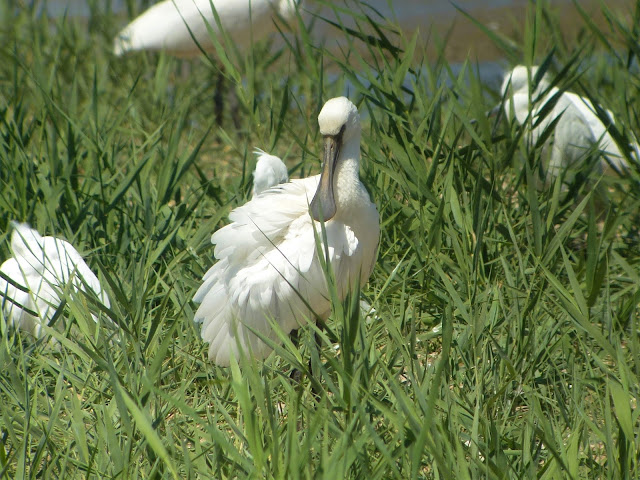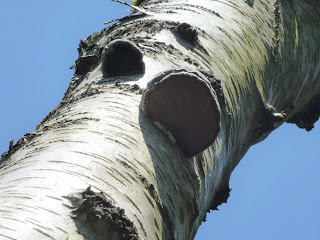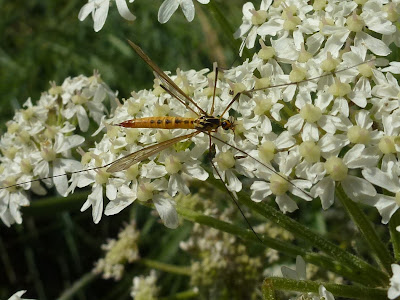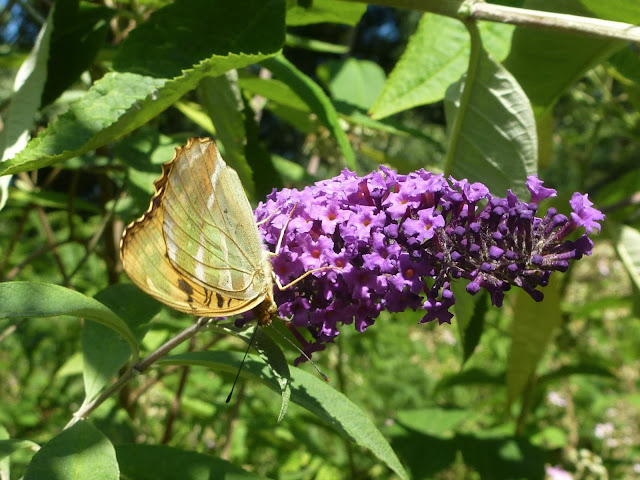It was a glorious day – as the forecast had said – as eight of us gathered in the car park of NWT’s nature reserve centre at Cley a little before 10 o’clock, where a whitethroat was singing. We learnt that opening time is exactly 10 am, so it was a very short wait to get our members’ stickers and to use the loos.
 |
| Spoonbill |
As
we headed into the marshes, a Mediterranean gull flew over, and soon after about three were on view on the scrape viewed from the first hide. We paused to look
at blue-tailed damselflies in ditches, a reed bunting, a common darter
dragonfly and various insects on hogweed, especially a tiger cranefly. Flowers studied
included perennial sowthistle with its yellow globular hairs, then hairy
buttercup Ranunculus sardous. The latter is similar to bulbous buttercup, including
reflexed sepals, but its distribution is strongly linked to coastal grazing
marshes.
The many gulls in front of the hide included some Mediterranean gulls and a single immature little gull, alongside more familiar species and some Sandwich terns. There were lots of black-tailed godwits, some russet-coloured, many avocets and lapwings, plus ruffs, greenshank, redshank and little ringed plovers. The waders all took to the air for a moment when a hobby came through. Many of the shelducks on view were this year’s birds – well-grown shelducklings, if that’s a word. Sand martins were feeding over the water, then scores perched on reeds on the skyline.
 |
| Black-tailed godwits, Mediterranean gull (centre), lapwing, black-headed and herring gulls. |
Birdwatching this morning wasn’t just a question of looking out of the viewing slots as adult swallows were constantly coming into the hide to their nest. There were three well-grown chicks in the nest.
 |
| Swallow and nest in the hide at NWT Cley Marshes. |
Walking on, we passed a hunting marsh harrier then a Norfolk hawker perching on a reed in a ditch, with not a single water soldier (as you’d expect in the Broads with this species of dragonfly) to be seen. The Norfolk hawker left its perch to mob a much bigger emperor dragonfly that was passing.
Our next viewing stop was Bishop’s Hide, in front of the island where the spoonbills had gathered: 14 in total, plus around 20 little egrets. A green sandpiper fed on the far side of the lagoon, and very close to us was a pair of eclipse plumage shovelers, their beaks obvious even though they’d lost their distinctive plumage.
There’d
been a scattering of butterflies all morning – such as ringlets, gatekeepers
and commas – and as we walked back towards the visitor centre, a red admiral landed
on Ann’s binoculars. We had our picnic lunches overlooking the reserve.Gatekeeper
There
was a ‘bonus’ afternoon stop at Stonepit Heath, Kelling. This was mostly to see
silver-washed fritillaries, and there were several of these fast-flying butterflies
around a big buddleia and patches of bramble. Other butterflies were common species:
perhaps we were a tad early for white admirals. Silver-washed fritillary.
Denise pointed out a hoof fungus on a birch, and that led us to another tree where there were several more, in various sizes. Under two of these we could make out the larval cases of hoof fungus gnats (the link is to a previous blog about these from March 2022), and this may well be another new site for this little-recorded invertebrate.
 |
| Hoof fungi, with cocoons from hoof fungus gnats under the lower fungus. |
On another fungal note, Rob pointed
out a piece of wood stained blue-green. The jade
coloration is the mycelium of the green elfcup fungus, once used in the
manufacture of Tunbridge ware, a form of decoratively inlaid woodwork.
 |
| Staining caused by green elf cup fungus. |







No comments:
Post a Comment